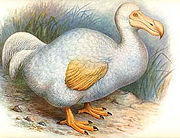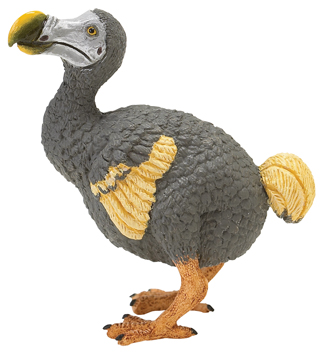
June 11, 2008

The dodo (Raphus cucullatus) was a flightless bird endemic to the Indian Ocean island of Mauritius, and went extinct several centuries ago, we are told.
But there remains some controversy surrounding the extinction date of the dodo.
In Nature 426, 245 (20 November 2003), David L. Roberts and Andrew R. Solow write in their paper, “Flightless birds: When did the dodo become extinct?” that “the extinction of the Dodo is commonly dated to the last confirmed sighting in 1662, reported by shipwrecked mariner Volkert Evertsz” (Evertszoon).
Other sources, however, suggest the date is 1681. Roberts & Solow point out that because the sighting prior to 1662 was in 1638, the dodo was likely already very rare by the 1660s, and that thus a disputed report from 1674 cannot be dismissed out-of-hand.
Statistical analysis of the hunting records of Issac Johannes Lamotius give a new estimated extinction date of 1693, with a 95% confidence interval of 1688 to 1715.
Considering more circumstantial evidence such as travellers’ reports and the lack of good reports after 1689, it is likely that the dodo became extinct before 1700. Sadly, the last Dodo died little more than a century after the species’ discovery in 1581.
Reports of sightings of living dodos in the 1990s on Mauritius prompted cryptozoologist William (“Bill”) Gibbons to mount expeditions to search for them. None were found.
Quite remarkably, dodos are back with us briefly and you can have two in the hand, instead of leaving any in the bush.
What I want to mention to readers of Cryptomundo is that two rather good small replicas of the dodo have appeared on the animal figurine scene this year. I would recommend to collectors and small exhibitors you may wish to pick them up before they become “extinct.”
They are hand-painted and quite beautiful.

One is from Papo, a French animal figurine maker.

The other is from the company Safari Ltd., headquartered in Florida and France. Of the two, it appears to be the more life-like and accurate to coloring. Dodos were a dull appearing bird, said to be gray to white. After all, dodos, while quite famous, are merely flightless, overgrown relatives of the pigeons. The dodo replica from Safari is highly recommended for your cryptozoological collection.
They hardly were here before they were gone, and the same thing could happen all over again.
Dodos’ destinies seem tied to disappearing.
About Loren Coleman
Loren Coleman is one of the world’s leading cryptozoologists, some say “the” leading living cryptozoologist. Certainly, he is acknowledged as the current living American researcher and writer who has most popularized cryptozoology in the late 20th and early 21st centuries.
Starting his fieldwork and investigations in 1960, after traveling and trekking extensively in pursuit of cryptozoological mysteries, Coleman began writing to share his experiences in 1969. An honorary member of Ivan T. Sanderson’s Society for the Investigation of the Unexplained in the 1970s, Coleman has been bestowed with similar honorary memberships of the North Idaho College Cryptozoology Club in 1983, and in subsequent years, that of the British Columbia Scientific Cryptozoology Club, CryptoSafari International, and other international organizations. He was also a Life Member and Benefactor of the International Society of Cryptozoology (now-defunct).
Loren Coleman’s daily blog, as a member of the Cryptomundo Team, served as an ongoing avenue of communication for the ever-growing body of cryptozoo news from 2005 through 2013. He returned as an infrequent contributor beginning Halloween week of 2015.
Coleman is the founder in 2003, and current director of the International Cryptozoology Museum in Portland, Maine.
Filed under Breaking News, Cryptomundo Exclusive, Cryptotourism, CryptoZoo News, Cryptozoologists, Cryptozoology, Extinct, Pop Culture, Replica Cryptia